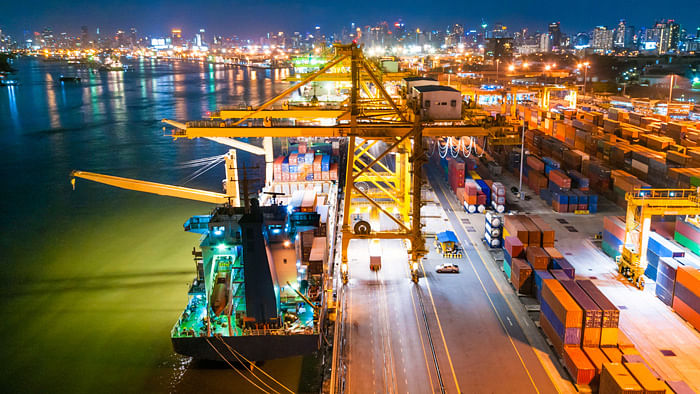Mumbai’s commercial seaport, which handles over half the container traffic through India’s major ports, is doubling capacity as Prime Minister Narendra Modi seeks to build an export powerhouse.
The expansion, due to be completed in seven years, can’t come quickly enough for Avinash Gupta, whose family business supplies steel forgings to Europe and the United States from the industrial hub of Ludhiana in northern India.
Yet the greatest challenge his $30 million business faces is getting his production to port. Gupta pays nearly $800 to a state-run rail cargo company to transport a 20-foot container to Mumbai – as much as 40 times the cost of shipping it onward to the Gulf commercial hub of Dubai.
It is exporters like Gupta that Modi had in mind when he launched his ‘Make in India’ drive last September, laying out a model of “port-led” development that would support industrial growth and help create manufacturing jobs.
Rising Costs
Gupta runs one of the thousands of small companies that contribute about half of India’s $300 billion in annual goods exports. Despite falling global prices, his costs have gone up, and his overseas sales are down more than 60%.
While shipping lines have slashed freight rates in search of business, state-run Container Corp of India actually raised rail rates by up to 15% in April – even though its fuel costs have fallen.
The hike in freight costs has made our life difficult. Since exports are already down 60-70% in the last three months, we will soon have to cut production.
– Avinash Gupta, Steel Exporter
Unless Modi’s government makes faster progress on stalled rail and road corridors, like one that would link Mumbai port to New Delhi and lower costs, India’s exporters will find it hard to compete on price and speed during the global trade downturn.

Nowhere is this more evident than at state-owned Jawaharlal Nehru Port Trust (JNPT), which last year signed a $1.26 billion deal with Singapore’s PSA International to build a fourth terminal in Mumbai on reclaimed land.

Modi has also acted to simplify export procedures, launching electronic clearance by customs, trade and port officials.
Ports are the gateway to trade growth. The government is expanding port capacity and building railway freight corridors and roads to reduce logistics costs for exporters. Trade is dynamic, we cannot wait till the end of global recession.
– Neeraj Bansal, Head of JNPT
The two-stage expansion by PSA International would boost capacity to around 11 million twenty-foot equivalent units (TEU). That would speed turnaround times and cut costs – it can take up to 12 hours for a truck to enter the port due to narrow approach roads, limited parking and customs delays. More than 10,000 trucks enter every day.
Imports, too, are hobbled by the poor infrastructure, with several container shippers imposing congestion surcharges of up to $200 per TEU to cover the cost of delays in unloading.
Congestion at major ports is predominantly caused by an inability to clear cargo from the quayside, and that manifests itself mostly on the bulk handling terminals on the east coast.
– Ian Claxton, Managing Director, Thoresen Shipping
Private Ports are Faster
Analysts estimate it takes up to four times as long to fill or unload a cargo ship at JNPT than at private rival the Adani Port and Special Economic Zone Ltd up the coast in Gujarat, Modi’s home state.
“Land connectivity plays a major role,” said Deven Choksey, managing director at KR Choksey Securities, a brokerage, adding that even after the expansion “the inherent disadvantages of JNPT will continue.”
India added 71 TEU of capacity at major ports in the fiscal year to March 31. Modi wants to double total capacity to 1,600 million tonnes at major ports over the next five years.

But businesses hit by the worst slide in exports since the global crisis of 2008 say Modi’s approach to easing rules for trade and expanding state-run ports fails adequately to tackle competitive barriers.
Even a delay of a few hours results in missing the vessel and sometimes cancellation of an order.
– Khalid Khan, Regional president, Federation of Indian Export Organisations
Modi’s Vision
Modi’s vision includes creating a tax union to slash costs and transport times, and a network of industrial corridors connecting the interior to ports. But political opposition to both the new tax and a law making it easier to buy land for development mean those may be years away.
For now, the inefficiencies are exacerbating the pain of weak global demand and a 15% drop in exports between December and June from a year ago.
Exporting a standard container requires seven documents, takes 17 days and costs $1,332 in India, according to the World Bank’s Doing Business 2015 report. India ranked 126th of 189 economies on the ease of trading across borders, well behind Mexico (44th) and China (98th). All of India’s ports together handle less trade than Shanghai alone.
(At The Quint, we are answerable only to our audience. Play an active role in shaping our journalism by becoming a member. Because the truth is worth it.)
